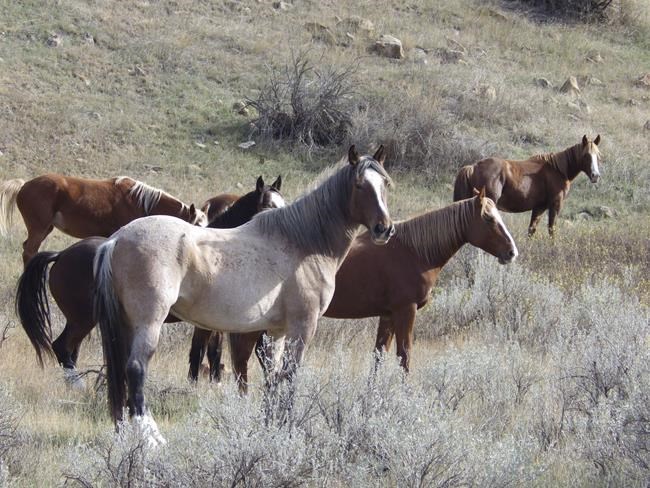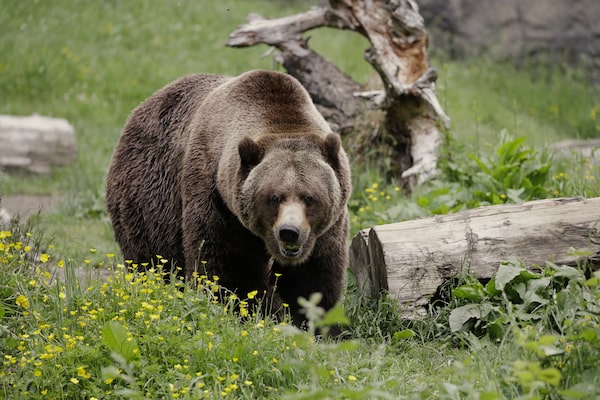SEATTLE
THE ASSOCIATED PRESS
ELAINE THOMPSON/THE ASSOCIATED PRESS
The federal government plans to restore grizzly bears to an area of northwest and north-central Washington, where they were largely wiped out.
Plans announced this week by the National Park Service and U.S. Fish and Wildlife Service call for releasing three to seven bears a year for five to 10 years to achieve an initial population of 25. The aim is to eventually restore the population in the region to 200 bears within 60 to 100 years.
Grizzlies are considered threatened in the Lower 48 and currently occupy four of six established recovery areas in parts of Montana, Idaho, Wyoming and northeast Washington. The bears for the restoration project would come from areas with healthy populations.
There has been no confirmed evidence of a grizzly within the North Cascades Ecosystem in the U.S. since 1996, according to the agencies. The greater North Cascades Ecosystem extends into Canada but the plan focuses on the U.S. side.
“We are going to once again see grizzly bears on the landscape, restoring an important thread in the fabric of the North Cascades,” said Don Striker, superintendent of North Cascades National Park Service Complex.
It’s not clear when the restoration effort will begin, the Seattle Times reported.
Fragmented habitat due to rivers, highways and human influences make it unlikely that grizzlies would repopulate the region naturally.
According to the park service, killing by trappers, miners and bounty hunters during the 1800s removed most of the population in the North Cascades by 1860. The remaining population was further challenged by factors including difficulty finding mates and slow reproductive rates, the agency said.
The federal agencies plan to designate the bears as a “nonessential experimental population” to provide “greater management flexibility should conflict situations arise.” That means some rules under the Endangered Species Act could be relaxed and allow people to harm or kill bears in self-defence or for agencies to relocate bears involved in conflict. Landowners could call on the federal government to remove bears if they posed a threat to livestock.
The U.S. portion of the North Cascades ecosystem is similar in size to the state of Vermont and includes habitat for dens and animal and plant life that would provide food for bears. Much of the region is federally managed.
The federal government plans to restore grizzly bears to an area of northwest and north-central Washington, where they were largely wiped out.
Plans announced this week by the National Park Service and U.S. Fish and Wildlife Service call for releasing three to seven bears a year for five to 10 years to achieve an initial population of 25. The aim is to eventually restore the population in the region to 200 bears within 60 to 100 years.
Grizzlies are considered threatened in the Lower 48 and currently occupy four of six established recovery areas in parts of Montana, Idaho, Wyoming and northeast Washington. The bears for the restoration project would come from areas with healthy populations.
There has been no confirmed evidence of a grizzly within the North Cascades Ecosystem in the U.S. since 1996, according to the agencies. The greater North Cascades Ecosystem extends into Canada but the plan focuses on the U.S. side.
“We are going to once again see grizzly bears on the landscape, restoring an important thread in the fabric of the North Cascades,” said Don Striker, superintendent of North Cascades National Park Service Complex.
It’s not clear when the restoration effort will begin, the Seattle Times reported.
Fragmented habitat due to rivers, highways and human influences make it unlikely that grizzlies would repopulate the region naturally.
According to the park service, killing by trappers, miners and bounty hunters during the 1800s removed most of the population in the North Cascades by 1860. The remaining population was further challenged by factors including difficulty finding mates and slow reproductive rates, the agency said.
The federal agencies plan to designate the bears as a “nonessential experimental population” to provide “greater management flexibility should conflict situations arise.” That means some rules under the Endangered Species Act could be relaxed and allow people to harm or kill bears in self-defence or for agencies to relocate bears involved in conflict. Landowners could call on the federal government to remove bears if they posed a threat to livestock.
The U.S. portion of the North Cascades ecosystem is similar in size to the state of Vermont and includes habitat for dens and animal and plant life that would provide food for bears. Much of the region is federally managed.
Wild horses to remain in North Dakota's Theodore Roosevelt National Park, lawmaker says
BISMARCK, N.D. (AP) — Wild horses will stay in North Dakota's Theodore Roosevelt National Park amid fears from advocates that park officials would remove the beloved animals from the rugged Badlands landscape, a key lawmaker said Thursday.

BISMARCK, N.D. (AP) — Wild horses will stay in North Dakota's Theodore Roosevelt National Park amid fears from advocates that park officials would remove the beloved animals from the rugged Badlands landscape, a key lawmaker said Thursday.

Wild horses stand in a group along a hiking trail in Theodore Roosevelt National Park on Saturday, Oct. 21, 2023, near Medora, N.D. U.S. Sen. John Hoeven, R-N.D., said Thursday, April 25, 2024, he has "secured a commitment" from the National Park Service to keep the roughly 200 horses that roam the park's South Unit. In 2022, the Park Service began a process that included proposals for removing the horses, which park visitors adore.
(AP Photo/Jack Dura)
Jack Dura,
Jack Dura,
The Associated Press
BISMARCK, N.D. (AP) — Wild horses will stay in North Dakota's Theodore Roosevelt National Park amid fears from advocates that park officials would remove the beloved animals from the rugged Badlands landscape, a key lawmaker said Thursday.
Republican U.S. Sen. John Hoeven said he has secured a commitment from the National Park Service to maintain the park's roughly 200 horses. His office said the Park Service will abandon its proposed removal of the horses under an environmental review process begun in 2022.
“This will allow for a healthy herd of wild horses to be maintained at the park, managed in a way to support genetic diversity among the herd and preserve the park’s natural resources,” Hoeven’s office said in a statement.
Park visitors, much to their delight, often encounter the horses while driving or hiking in the rolling, colorful Badlands where a young, future President Theodore Roosevelt hunted and ranched in the 1880s.
The horses roam the park’s South Unit near the Western tourist town of Medora. In 2022, park officials began the process of crafting a “livestock plan” for the horses as well as about nine longhorn cattle in the park’s North Unit near Watford City. Park officials have said that process aligned with policies to remove non-native species when they pose a potential risk to resources.
“The horse herd in the South Unit, particularly at higher herd sizes, has the potential to damage fences used for wildlife management, trample or overgraze vegetation used by native wildlife species, contribute to erosion and soil-related impacts ... and compete for food and water resources,” according to a Park Service environmental assessment from September 2023.
Proposals included removing the horses quickly or gradually or taking no action. Park Superintendent Angie Richman has said the horses, even if they ultimately stay, would still have to be reduced to 35-60 animals under a 1978 environmental assessment. It wasn’t immediately clear how Hoeven’s announcement affects the future number of horses or the longhorns.
Thousands of people made public comments during the Park Service review, the vast majority of them in support of keeping the horses. North Dakota’s Republican-controlled Legislature made its support official in a resolution last year. Gov. Doug Burgum offered state help to maintain the horses.
Hoeven's announcement comes after Congress passed and President Joe Biden recently signed an appropriations bill with a provision from Hoeven strongly recommending the Park Service maintain the horses. The legislation signaled that funding to remove the horses might be denied.
The horses descend from those of Native American tribes and area ranches and from domestic stallions introduced to the park in the late 20th century, according to Castle McLaughlin, who researched the horses as a graduate student while working for the Park Service in North Dakota in the 1980s.
Jack Dura, The Associated Press
Republican U.S. Sen. John Hoeven said he has secured a commitment from the National Park Service to maintain the park's roughly 200 horses. His office said the Park Service will abandon its proposed removal of the horses under an environmental review process begun in 2022.
“This will allow for a healthy herd of wild horses to be maintained at the park, managed in a way to support genetic diversity among the herd and preserve the park’s natural resources,” Hoeven’s office said in a statement.
Park visitors, much to their delight, often encounter the horses while driving or hiking in the rolling, colorful Badlands where a young, future President Theodore Roosevelt hunted and ranched in the 1880s.
The horses roam the park’s South Unit near the Western tourist town of Medora. In 2022, park officials began the process of crafting a “livestock plan” for the horses as well as about nine longhorn cattle in the park’s North Unit near Watford City. Park officials have said that process aligned with policies to remove non-native species when they pose a potential risk to resources.
“The horse herd in the South Unit, particularly at higher herd sizes, has the potential to damage fences used for wildlife management, trample or overgraze vegetation used by native wildlife species, contribute to erosion and soil-related impacts ... and compete for food and water resources,” according to a Park Service environmental assessment from September 2023.
Proposals included removing the horses quickly or gradually or taking no action. Park Superintendent Angie Richman has said the horses, even if they ultimately stay, would still have to be reduced to 35-60 animals under a 1978 environmental assessment. It wasn’t immediately clear how Hoeven’s announcement affects the future number of horses or the longhorns.
Thousands of people made public comments during the Park Service review, the vast majority of them in support of keeping the horses. North Dakota’s Republican-controlled Legislature made its support official in a resolution last year. Gov. Doug Burgum offered state help to maintain the horses.
Hoeven's announcement comes after Congress passed and President Joe Biden recently signed an appropriations bill with a provision from Hoeven strongly recommending the Park Service maintain the horses. The legislation signaled that funding to remove the horses might be denied.
The horses descend from those of Native American tribes and area ranches and from domestic stallions introduced to the park in the late 20th century, according to Castle McLaughlin, who researched the horses as a graduate student while working for the Park Service in North Dakota in the 1980s.
Jack Dura, The Associated Press

No comments:
Post a Comment